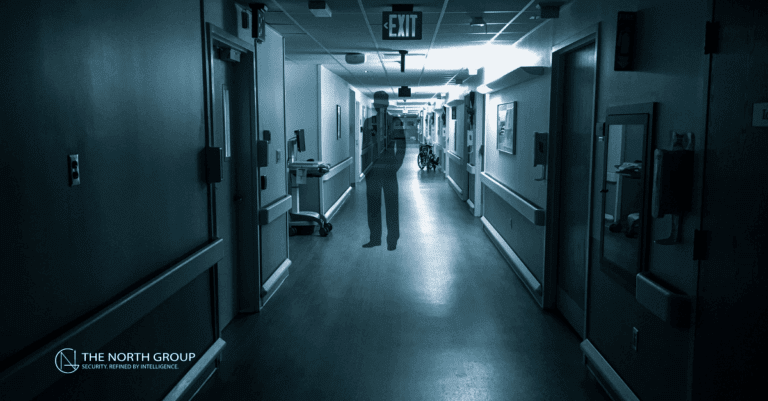Organizations face unprecedented security challenges during periods of heightened political activity, with traditional security approaches requiring adaptation to address disinformation campaigns, digital threats, and hybrid warfare tactics that blur the lines between information operations and physical security concerns. The North Group has developed comprehensive protocols that enable institutions to maintain operational effectiveness while protecting personnel and assets in increasingly complex threat environments.
The Contemporary Security Challenge
Modern institutional security now operates within information environments where disinformation can spread rapidly, reshaping public perception in real time. These campaigns can fuel hostility toward organizations, undermine trust, and even escalate into targeted harassment or violence against personnel. Because of this, understanding how information warfare overlaps with traditional security concerns is no longer optional, it’s essential. Comprehensive protection strategies must account for both digital and physical threats, treating them as interconnected risks that demand simultaneous attention.
Disinformation campaigns often work by undermining institutional credibility. False claims about organizational activities, leadership decisions, or supposed political ties are designed to spark public hostility and division. When these narratives gain traction, they can turn otherwise routine operations into potential security risks, fueled by amplified controversies or manufactured outrage that drives hostility toward personnel or facilities.
The speed of today’s digital landscape means false narratives can spread in minutes, not weeks.
For organizations, that creates a need for rapid response systems that can catch and counter disinformation before it spills over into real-world security risks. Traditional security planning often moves too slowly to keep pace. When hostile actors can launch coordinated campaigns that reach massive audiences within hours, even routine timelines leave dangerous gaps in protection.

The amplification of political tensions on social media can distort reality in dangerous ways. A single incident can be made to look like a widespread pattern, pressuring institutions into overreacting. The result? Heavy-handed security measures that disrupt normal operations and create more problems than they solve.
Conversely, dismissing legitimate security concerns as manufactured controversy carries its own risks. It can leave organizations unprepared for real threats that emerge from grievances shaped, and inflamed, by disinformation.
Enhanced Physical Security Frameworks
Layered defense strategies must recognize how disinformation changes the equation. False narratives can give hostile actors a sense of justification, a reason, however unfounded, to target facilities or personnel. Even standard security measures, like standoff distances, demand rethinking in this environment. Social media campaigns can rapidly mobilize large groups, directing them toward institutional targets based on nothing more than distorted claims about organizational activities or decisions.
Perimeter hardening remains one of the most visible and effective layers of defense. Fencing, bollards, and vehicle-resistant barriers not only delay forced entry attempts but also act as deterrents, signaling to opportunistic attackers – including those motivated by disinformation – that the target will not be easily breached.
Technology strengthens this foundation. Advanced surveillance with video analytics enables real-time threat detection while also documenting events. That documentation is critical: it provides clear evidence to counter false claims about institutional security responses or the treatment of protesters.
Redundancy is equally important. Emergency backup power ensures critical security systems remain active during disruptions, particularly those caused by coordinated campaigns that combine physical sabotage with cyber operations. Likewise, redundant communication systems guard against isolation when hostile actors attempt to manipulate or control information about a developing incident.

Visitor management deserves heightened focus during politically sensitive periods. False IDs, coordinated entry attempts, or impersonation tactics can all be used to gain unauthorized access. Digital pre-registration with enhanced background checks helps flag risks before individuals reach the perimeter, while multi-factor authentication, including biometric verification, reduces the chance of impostors exploiting compromised credentials.
Finally, access control must account for insider threats. Disinformation campaigns can compromise personnel through social engineering, blackmail, or even ideological persuasion. Regular audits and behavioral monitoring help identify unusual access patterns or changes in professional conduct that may signal a developing concern, before it escalates into a critical breach.
Advanced Staff Training and Preparedness
Comprehensive training is no longer just about physical security. It must also account for the way disinformation shapes behavior, both at the individual level and across the organization during a crisis. Situational awareness training should prepare staff to recognize not only traditional threat indicators, but also the subtle signs of information manipulation. False urgency, misdirection, and confusion are deliberate tactics, and staff need the skills to spot and resist them in real time.
Social media literacy plays a critical role as well. Personnel must learn to identify disinformation techniques and avoid unintentionally amplifying false narratives that could compromise institutional security or create additional threats. Just as importantly, they need to understand how hostile actors exploit emotion (fear, anger, or outrage) to spread false information. With this awareness, staff are better equipped to maintain operational effectiveness in information-heavy crisis environments.
Cross-functional participation is essential for building a truly coordinated response. Different departments face different risks, and disinformation campaigns often exploit those unique vulnerabilities to spark internal conflict or division. Training together helps close those gaps before they can be exploited.
Drills should be routine during normal operations, but their frequency and complexity need to increase during high-threat periods. Elevated practice ensures that when real incidents occur, teams are not only prepared but already conditioned to respond with cohesion and confidence.
Emergency communication procedures must be built on redundancy. When primary systems face technical attacks or coordinated disruption, backup channels need to remain reliable and ready.
Training is equally important. Personnel should be prepared to use alternative communication methods and follow verification protocols that reduce the risk of hostile actors exploiting emergency systems to spread false information or misdirect response efforts.
Strategic Communication and Counter-Disinformation
Strategic communication is more than sharing updates — it’s about shaping clarity and consistency before false narratives can take hold. Proactive messaging, timely updates, and clear points of contact reduce the space in which disinformation can spread internally.
Counter-disinformation efforts also require discipline in emergency alerts. Multi-channel systems must be backed by strict verification procedures to ensure that staff can trust the messages they receive. This trust is essential for preventing confusion, panic, or misdirection during a crisis.
Leadership communication must strike a careful balance: being transparent enough to build trust, while protecting operational details that could compromise security. Clear and consistent messaging reduces uncertainty and strengthens confidence during high-stress situations.
Pre-approved statements with rapid deployment capabilities are especially valuable. They allow leaders to respond quickly and consistently, closing the gaps where hostile actors might otherwise insert false narratives or exploit an information vacuum.

External communication strategies must include active monitoring of social media and alternative channels where disinformation often begins before reaching mainstream outlets. By tracking these spaces, organizations can identify harmful narratives early, before they gain traction. Speed is essential. Rapid response capabilities allow institutions to correct false information before it spreads widely or fuels hostility toward personnel, facilities, or operations.
Equally important are public/private partnerships. Coordinating with community stakeholders, government agencies, and peer organizations strengthens the ability to share accurate information quickly. These partnerships provide trusted voices that help counter disinformation and maintain public confidence during periods of heightened tension.
Media relations protocols must account for how disinformation campaigns seek to exploit interviews or public statements, often by reframing content in ways that generate controversy or remove critical context. Anticipating these tactics is essential for reducing vulnerability. Training for designated spokespeople should emphasize strategies for addressing false claims without inadvertently amplifying conspiracy theories or creating new material that could be manipulated. Consistency and discipline in public communication reinforce credibility while limiting opportunities for disinformation to gain traction.
Community engagement strategies should focus on building authentic relationships that are resilient to manipulation by false narratives. Transparency around security measures and threat assessment processes strengthens trust and reduces the space in which disinformation can take hold. Regular communication with stakeholders further reinforces credibility. When disinformation campaigns attempt to target institutional reputation or activities, established trust makes counter-messaging more effective and more likely to be received as credible.
Technology Integration and Digital Security
Advanced technology platforms must address not only traditional security concerns but also the digital threats that increasingly accompany physical incidents. A fragmented approach leaves exploitable gaps. Integrated systems that combine physical access control, surveillance, and cybersecurity monitoring provide broader visibility and stronger detection capabilities. By unifying these domains, organizations reduce the chances of hostile actors exploiting weak points between them.
Artificial intelligence can strengthen security by analyzing vast volumes of social media content to detect emerging disinformation campaigns before they escalate into real-world threats.
Machine learning algorithms are particularly effective at identifying coordinated operations and spotting artificial amplification patterns. These tools provide early warning signals, giving organizations more time to prepare for and counter threats driven by disinformation.
Digital forensics capabilities allow security teams to trace hostile communications back to their source and separate organic threats from coordinated campaigns. This distinction is critical when disinformation is used to overwhelm institutional resources or create the illusion of widespread hostility. Technical analysis also reveals the manipulation techniques and coordination patterns that point to professional disinformation operations, helping organizations respond appropriately rather than misclassifying them as grassroots concerns.
Backup communication systems must be secured against both technical attacks and social engineering attempts that may occur alongside physical security incidents.
Redundant information systems with independent power sources and communication channels ensure organizations can maintain coordination during extended disruptions or coordinated attacks that target multiple infrastructure systems at once.
Crisis Management and Business Continuity
Disinformation adds a layer of complexity to crisis management by disrupting coordination and decision-making in real time. False reports about an incident’s scale or the effectiveness of the response can slow down operations, create uncertainty, and erode confidence just when clarity is needed most. Clear internal communication procedures are essential. They reduce the risk of hostile actors exploiting confusion to spread false narratives about institutional responses or to create additional security concerns.
Business continuity planning must account for how coordinated attacks that blend physical and information components can disrupt operations well beyond the initial incident.
Effective planning considers not only the immediate consequences but also the second- and third-order effects that ripple across the organization. Remote work capabilities are a critical part of this resilience. Secure communication systems must be in place to resist infiltration or manipulation, ensuring coordination continues even when hostile actors attempt to exploit a crisis.
Financial continuity measures must account for reputational risks created by disinformation campaigns. These risks extend beyond the immediate incident, affecting customer confidence, vendor relationships, and stakeholder support — all of which are essential to organizational resilience over the long term. Comprehensive insurance coverage is another layer of protection. Policies should reflect the modern threat environment, accounting for potential losses from coordinated attacks that combine traditional security threats with information warfare components. Addressing these vulnerabilities strengthens both financial stability and the organization’s ability to recover effectively.

Legal preparedness involves anticipating how disinformation campaigns might generate false claims about institutional activities. These claims can escalate into litigation, regulatory scrutiny, or even law enforcement inquiries, all of which demand sophisticated legal response capabilities.
Thorough documentation is equally important. Maintaining detailed records not only supports a credible defense against false narratives but also ensures sensitive security information remains safeguarded from unnecessary disclosure. Recovery planning should extend beyond operational concerns to include reputation management. The long-term effects of disinformation can outlast the immediate crisis, influencing public perception and stakeholder trust well after the incident is contained. Post-incident communication strategies are critical in this phase. They should focus on rebuilding confidence while integrating lessons learned about both disinformation tactics and organizational vulnerabilities. This ensures recovery strengthens resilience rather than simply restoring the status quo.
Implementation and Continuous Improvement
Resource allocation requires a careful balance. Traditional security measures remain essential, but they must be complemented by emerging capabilities designed to address the information warfare components of today’s threat environment. Technology investments should prioritize systems that strengthen multiple security domains at once while allowing rapid adaptation to evolving threat patterns and attack methods.
Training programs must evolve continuously as disinformation techniques grow more sophisticated and increasingly target specific institutional vulnerabilities. Regular assessments of personnel preparedness ensure capabilities keep pace with these evolving threats, while still supporting operational effectiveness in day-to-day activities.
Success metrics should extend beyond traditional measures of security performance. They must also evaluate resilience against information warfare attacks that may not cause immediate physical harm but can create long-term vulnerabilities if left unaddressed. Comprehensive evaluation frameworks help determine whether an organization can sustain effectiveness while operating under sustained information pressure.
Partnerships are another critical element of preparedness. Collaborating with peer organizations facing similar threats enables shared learning and strengthens collective defense against coordinated disinformation campaigns. Industry-wide cooperation also provides early warning systems and intelligence-sharing networks that no single institution could build alone.

The modern threat environment demands integration. Traditional security measures must be combined with advanced capabilities that address information warfare and hybrid tactics. Organizations that adopt comprehensive approaches will be best positioned to maintain operational effectiveness while protecting against today’s challenges and adapting to tomorrow’s evolving attack vectors.
Staying ahead requires more than reacting to the latest threat. It demands proactive investment in people, processes, and partnerships that strengthen resilience over the long term. Organizations that begin adapting now will be better prepared to safeguard both their operations and their reputation in the face of evolving disinformation challenges.
About The North Group: The North Group provides comprehensive security consulting and intelligence services addressing traditional and emerging threat environments. Our experienced professionals help organizations develop effective security postures that account for information warfare, cyber threats, and hybrid attack methodologies while maintaining operational effectiveness. For specialized security consulting services, visit www.tngdefense.com.








